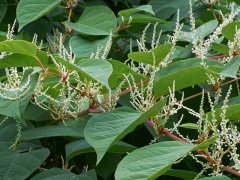Control of Japanese Knotweed
Japanese knotweed (JDK), Fallopia japonica, is an "invasive exotic species." An exotic is a plant (or animal) that does not naturally occur here. Invasive means that it multiplies enormously fast, to the detriment of natural vegetation. Not only that: with its strong root system, JDK affects roads, pipes and buildings. An unusual and unwanted plant, it is difficult to eradicate.
Locations in Son en Breugel
Countless ways to eradicate Japanese knotweed have been tried, but it is proving very difficult. Currently, "depletion" seems to be the best method. Exhaustion involves removing the parts that protrude above the ground. Again and again. Until eventually the plant is 'exhausted' and therefore eradicated.
Joep Thurlings, a resident of Son en Breugel, has experience with this method of control. Together with a team of volunteers, he is committed to eradicating the JDK in cooperation with the municipality. It is important to map all the places where the JDK occurs Map
How can the plant be recognized?

With the JDK, it is noticeable that the young shoots are reddish-brown in color and at the nodes-that is, the places where the leaves are attached to the stems-the stems are colored reddish-brown. Other plants do not have this. See photos here to help identify the plant.
Features at a glance:
- 1 to 3 meters high
- Hollow, erect stems with reddish-brown spots
- ovoid, somewhat leathery leaves, without hairs on the underside
- Leaf length: 10 to 15 cm long
- Small creamy-white, sometimes white-pink flowers from July through September.
Location report
We already have 44 JDK locations listed. Do you know a location in Son en Breugel that is not on the list? Please report it as soon as possible via JDK@sonenbreugel.nl or via our website.
Volunteers wanted
Would you like to help in the fight against Japanese knotweed? Then send a message to
JDK@sonenbreugel.nl. We will forward applications to the volunteer coordinator.